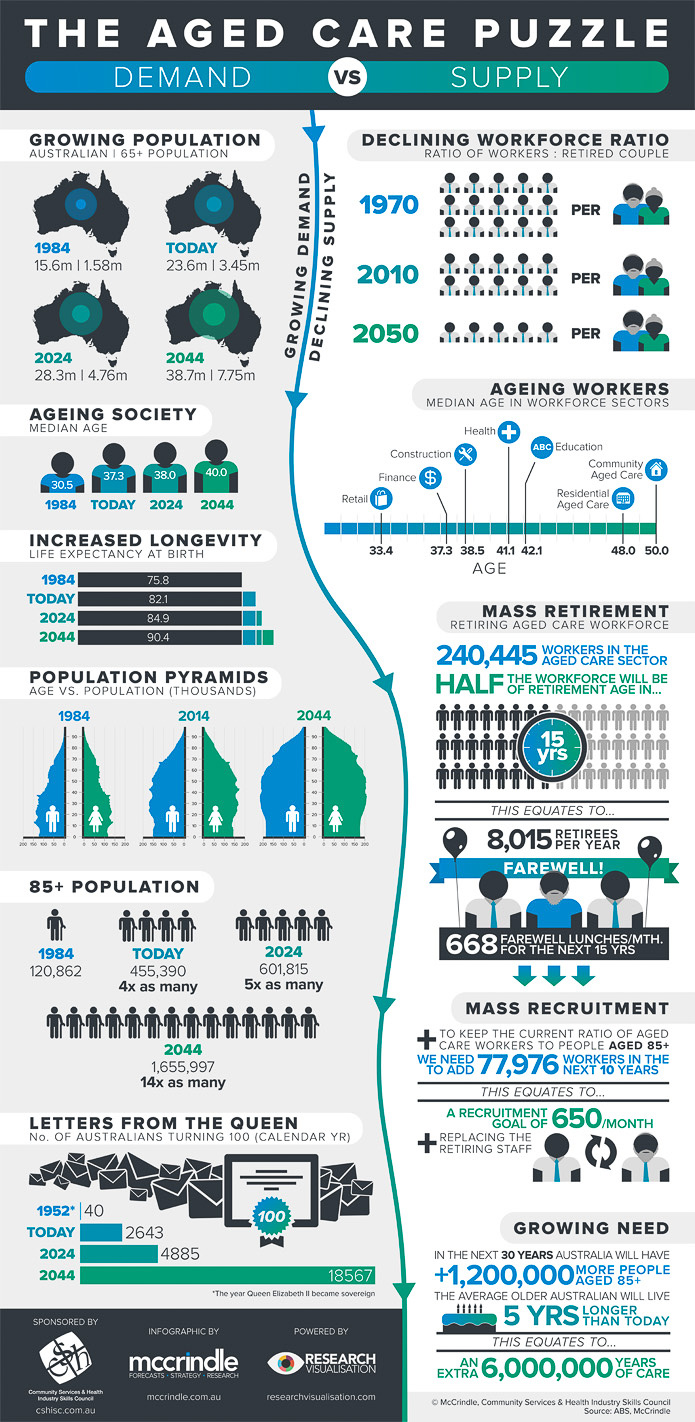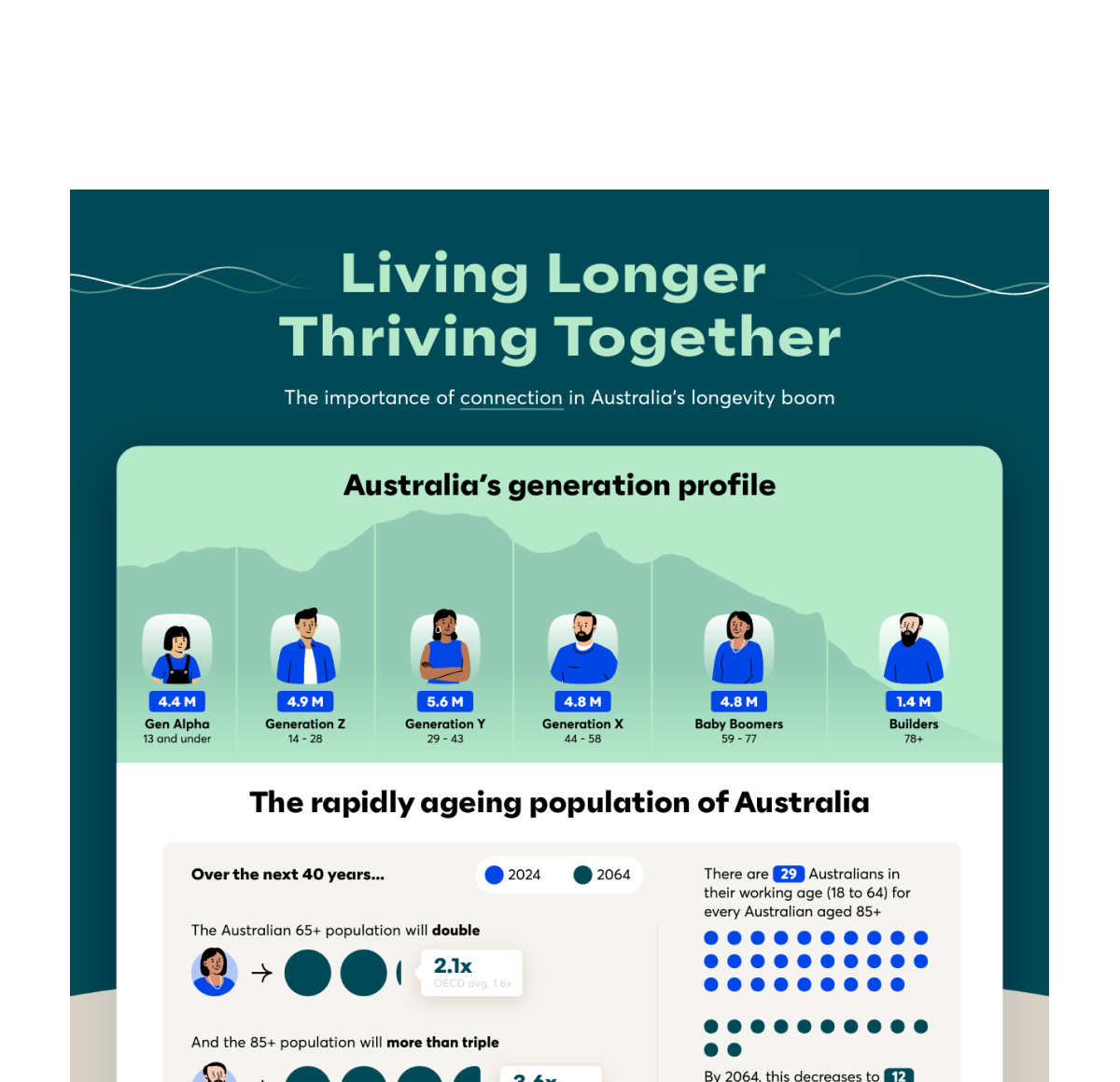Demand Vs. Supply: Australia’s Aged Care Puzzle

With Australia’s ageing population, increased life expectancy and longevity, there are growing demands for aged care in our nation.
Australia’s aged care sector is under pressure to meet this growing demand while at the same time facing significant recruitment and workforce challenges with half of the current aged care workforce reaching retirement age in the next 15 years.
McCrindle crunches the numbers in the latest infographic, the Aged Care Puzzle, to determine the magnitude of the demand versus supply gap.
The challenge of demand
Australia as an ageing nation
Australia is experiencing a baby boom, with births exceeding 315,000 a year, as well as an increasingly ageing population. The over 65s make up 15% of our population today, and forecasts project that this cohort will make up 17% in 2024, and by 2044, 1 in 5 Australians (20%) will be aged over 65.
Australia’s population pyramids visually show the growth of our ageing population, and in 2044 our population pyramid will become inverted with the number of over 60s outnumbering the under 18s for the first time. Our median age is also increasing – three decades ago the median age of an Australian was 30.5, today it is 37.3 and in 2044 it is projected to be 40.
The over 85s, where there is an even greater need for aged care services, are growing at an even faster rate than the over 65s. In 1984 there were 120,862 Australians aged over 85, today there are 4 times as many, and in 2044 there will be 14 times as many.
Not only are there more older people in our nation but Australians are living longer than ever before. Life expectancy at birth in 1984 was 75.8, whereas today it exceeds 80 for a male and 84 for a female. In 2044, it is projected to be 90.4.
Health advancements are increasing longevity
The primary enabler of this increased and ongoing longevity gain has been the health system rather than individual behaviour. Life expectancy increases will continue because of improved medical technologies, public health infrastructure, better public health measures, new and improved medical interventions and the improved survivability rates of major illnesses and cancers.
The health system is also what will keep us living longer in the future. With Australians living longer than ever before, there will be an increasing need for procedures and medical intervention, and a growing expectation from the public that these services will continue to be provided.
A decade ago, dementia and Alzheimer’s disease were the 6th largest causes of death in Australia, accounting for 4,364 deaths in 2002. Today they are the 3rd leading causes of death with the number of deaths having more than doubled to 9,864. Over the same period of time, deaths due to the first and second causes of deaths (heart disease and brain disease) have been decreasing. If today’s current trend continues over the next decade, by 2021 dementia and Alzheimer’s disease will be the leading cause of death in Australia.
With little change in the retirement age and an increase in longevity, the retirement years have increased and the years for which supported care is needed has also increased. Not only is our population larger, our population is also living longer.
Exponential growth of centenarians will keep the Queen busy
In 1952, the year that Queen Elizabeth II became sovereign, 40 letters of congratulations would need to have been written for Australians turning 100. This year, 2,643 Australians will turn 100 and in 30 years the number of congratulatory letters written to Australians turning 100 will increase to 18,567 in the year 2044.
The challenge of supply
Not only is there an increasing demand on the services provided by the aged care sector with the growing number of over 85s, there is also a workforce supply challenge.
Ratio of Workers to Retirees Declining
The ageing population will place greater demands for productivity on the labour force. In 1970, for every couple of retirement age there were 15 people in the working age population, by 2010 there were just 10 people of working age for every couple of retirement age, and this is projected to decline to just 5 people of working age for every couple at retirement age by 2050.
An Ageing Workforce
Along with our ageing population, we also have an ageing workforce. Today the median age of an Australian is 37.3 and the median age of a worker is 40. However this varies across sectors – for example, the median age in the retail sector is 33.4, finance 37.3, construction 38.5, health 41.1, education 42.1. However in the aged care sector this ageing is even more pronounced – the median age for a residential direct care worker is 48 and community direct care workers is 50 years which makes it the sector with the highest median age of an employee.
Impending retirements
Because of the high median age of an employee in the aged care sector, half of the aged care workforce will be of retirement age in 15 years. There are 240,445 workers in the aged care sector, so this equates to an average of 8,015 retirements per year for the next 15 years, which averages to 668 farewell lunches per month.
If we are to keep the current ratio of aged care workers to people aged over 85 in our nation, we need to add 77,976 workers in the next 10 years, which equates to recruiting 650 new workers per month, in addition to replacing the 668 retiring staff per month.
A Growing Need
In the next 30 years Australia will see an unprecedented rate of growth of the over 85s in our nation. In 2044 there will be 1.2 million more people aged over 85 than there are today, and the average older Australian will live 5 years longer than today which equates to adding 6 million more years of care just for the increased number of over 85s and just to manage their increased life expectancy.






